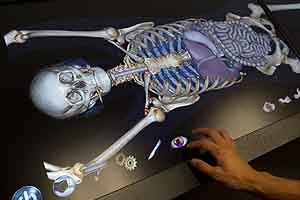
A couple of weeks ago we posted about the datafication of everything, with a few examples of what can be quantified, and what we can do with that quantified data.

A couple of weeks ago we posted about the datafication of everything, with a few examples of what can be quantified, and what we can do with that quantified data. And while the advent of Google Glass has made it so that we can absorb gobs more data, there are so many other products that we haven’t heard about that can give us measurable metrics on any and all facets of our lives. Couple that with Big Data technologies employed by healthcare providers, as well as the predictive analysis capabilities of technologies like Hadoop, and we should see a convergence of these that will someday contribute to a decrease in preventable illnesses and diseases.
Favorite data collector? A toilet! From the people that brought you the don’t burn yourself with your noodle soup head and neck protector, the handy dandy who needs a pack of tissues in your pocket when you can keep it on your head device, and the I wish I could see inside my ear, Hey I can!: You can now get data output on your own output. Granted this data collecting toilet has been around for a few years, but with the emphasis on data collection of every kind becoming the norm, it only seems natural to revisit this invention, as well as similar technologies, and the benefits they present.
This commode collects vitals such as BMI and blood sugar from the user. It then alerts him/her to any discovered irregularities. Meaning, it collects and stores your data, and shows you what’s wrong.
Strangely enough, toilets aren’t the only things collecting and storing your health related data for future use. Hospitals, doctors, and health insurance providers (if you’re lucky enough to have one) store every single piece of data about you, from the details of your calls to the claims centers, to lab results, to pharmacy orders (as I’m typing this, it’s getting a little scary). What if they could do predictive analysis on your records and calls to see what kind of programs you might need, or compare your lab results and doctors notes to everyone else’s to see if you’re heading towards a certain diagnosis and what possible solutions you’ll require, all done with the idea of preventing you from getting there in the first place? They can and they are.
Now imagine all of this is combined together, as well as with other technologies only dreamed about a decade ago. Smart refrigerators know what and how much you’re eating. By scanning barcodes and upc’s, the fridge also knows exactly what’s in the food you’re eating. After you eat, mechanisms in your house will be collecting samples (after you’ve clicked accept on the EULA of course). Imagine these are connected to a personal home data center with your very own Hadoop clusters running real time analytics on you and your food, pre and post ingestion. Let’s say certain conditions are discovered, that thanks to data gathered from other people’s home appliances, that are known precursors to certain health problems. Before the person in question develops the condition, the home analytics begin coordinating with doctors, the insurance company, and pharmacy if necessary, to make suggestions on what to eat more or less of, and even what sort of medicines will be needed to prevent the disease from ever becoming a problem.
But that’s not all. There are apps for everything, including exercise apps that collect the data of everyone that uses them. What if we could take the data collected by your appliances and healthcare systems and coordinate that information with the various data collected by the exercise and sports apps, to customize a program tailored specifically to your needs, to bring all your various health readings to normal levels. Just picture it, a gigantic Hadoop cluster that looks like the end of Matrix Revolutions collecting everyone’s information, comparing it, and using it to help people stay healthy.
All because of a toilet with a computer in it.
image: courtesy of Norbert von der Groeben and Stanford University